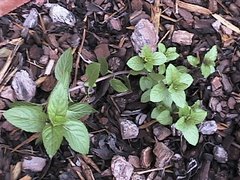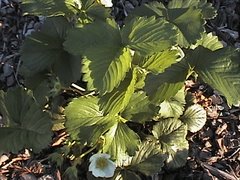Growing Great Strawberries
By Michael Russell
You can choose from three different types of strawberries, depending on when you want fruit. Consult your local extension office or nurseries for the best varieties for your area. June-bearing varieties produce one large crop of berries in late spring to early summer. Everbearing varieties produce two smaller crops - one in the early summer and another in early fall. Day-neutral berries, the newest type, con produce fruit continuously throughout the growing season.
Plant dormant, bare-root strawberry plants 18 to 24 inches apart in 3- to 6-inch high 3- to 4-foot wide raised beds. Set the plants so that soil covers the roots, but the crown remains above the soil. Keep the soil moist but not saturated. Pinch off all flowers until mid-summer for the first season to encourage strong root and top growth.
The plants that you set out are called the mother plants. They send out runners that take root and develop new daughter plants in mid to late summer. Space the daughter plants evenly around the mothers to give each plenty of space to grow. Daughter plants flower and fruit the year after they grow. In the second summer you can remove the original mother plant to make room for new daughter plants. Another method is to rotary till the sides of the bed in mid-summer of he second or third year, leaving plants only in the 18- to 24-inch wide center strip. Train new daughter plants into the tilled soil. Plan to replace your strawberry planting every 3 to 5 years. Cover the planting with straw mulch after the ground freezes in cold-weather climates and remove as the weather warms in spring.
One of the most serious insect pests that affect strawberries is the tarnished plant bug, which can severely damage the developing fruit. These insects spend the winter in plant debris and live on weeds in and around your yard. Covering the strawberry plants in the fall with a floating row cover can offer some, but not complete protection from the bugs in the following spring and early summer. Early ripening varieties often suffer less damage than late-season berries.
The strawberry clipper or bud weevil is another significant pest in some areas. This insect flies into the planting from neighborhood woodlots and hedgerows about the time that the flower buds swell. Adults destroy the developing buds by laying eggs in them. Many other insects, slugs, mites and nematodes attack strawberry fruits and plants, reducing vigor and production and introducing disease. Birds and ground squirrels will also take their share.
Strawberries are also subject to many fungal, bacterial and viral diseases. Fungal infections include leaf spot, leaf scorch, leaf blight, powdery mildew, red stele, Verticillium wilt, root rot and several berry rots. Avoid planting strawberries where tomatoes, eggplants or potatoes previously grew to avoid wilt diseases. Buy only virus-free plants from a reputable nursery.
Michael Russell
Your Independent guide to Gardening
Article Source: http://EzineArticles.com/?expert=Michael_Russellhttp://EzineArticles.com/?Growing-Great-Strawberries&id=216938
Friday, March 30, 2007
Tuesday, March 27, 2007
Organic Vegetable Gardening for Beginners
Organic Vegetable Gardening for Beginners by Mary Hanna
To be successful at organic vegetable gardening you must draw up detailed plans. The soil is your first consideration; how to make it rich and fertile, and how to prepare it so harmful pests won't attack your vegetable garden. The two ways that organic vegetable gardening differs from conventional gardens is the usage of fertilizer and how to keep pests under control. Phosphorous, nitrogen and potassium are the three components essential to your organic garden.
For lush, green foliage you must have nitrogen. For strong roots and stems phosphorus is needed. And for the important protection from disease and brief cold snaps, potassium is a must. Let's call them the big three. The big three are available in commercial fertilizers however they are synthetic. In organic vegetable gardening the big three are added in a much different way.
The best way of enriching your soil is by compost. Dig some pits in your back yard to start your compost from kitchen refuse. Use things like pine needles, corn stalks, leaves, carrot tops, fruits or vegetables that have spoiled, manure, egg shells and coffee grinds. Some organic gardeners use weeds in their compost but I do not recommend this for obvious reasons. As the compost materials decompose they release bacteria and fungi into the soil that you are preparing. The bacteria and fungi convert nutrients like nitrogen to ammonia and nitrates that will be usable for your vegetables. Use substances such as seaweed, potash salts, tobacco stems and wood ash to help make potassium in your compost. By making your own compost, you are controlling the mixture and balance to achieve the right combination for your organic vegetable garden.
To be absolutely sure that your compost has completely broken down and is now offering up the right balance, start working it into the soil at least two weeks before you plan on planting.
The pH in the soil must be right for healthy plants. Test your soil, if it has a ph of 0 it is very acidic, while a 14 is extreme alkaline. Of course a seven indicates neutral soil. To raise the pH of the soil inexpensively use ground limestone. An additional benefit of the limestone is that it contains magnesium something that most soils lack. If, on the other hand, you have extreme alkaline soil use sulpher to bring the pH down.
Pest control in organic vegetable gardening is also different that conventional gardening. In many conventional beds gardeners wish to eradicate all pests with pesticides. Many in organic gardening only wish to keep the pest population down so to have a balance in the garden. Obviously, whenever possible, plant pest resistant vegetables. In order for harmful organisms to grow, they need bright sunlight so keep thick mulch around the plants to deny the organisms that needed sunlight and to help hold moisture into the ground. If you find you have a heavy infestation here is a natural pest control formula:
In a jar, combine 1 teaspoon dishwashing liquid and 1 cup vegetable oil. Shake vigorously. In an empty spray bottle, combine 2 teaspoons of this mixture and 1 cup water. Use at ten-day intervals (or more often if needed) to rid plants of whiteflies, mites, aphids, scales, and other pests.
Follow this tips and you are on your way to raising a healthy and plentiful organic vegetable garden.
Happy Gardening!
Copyright © Mary Hanna, All Rights Reserved.
This article may be distributed freely on your website and in your ezines, as long as this entire article, copyright notice, links and the resource box are unchanged.
Mary Hanna is an aspiring herbalist who lives in Central Florida. This allows her to grow gardens inside and outside year round. She has published other articles on Cruising, Gardening and Cooking. Visit her websites at Gardening Landscaping Tips, Gardening Outside and Herb Gardening
Article Source: http://EzineArticles.com/?expert=Mary_Hannahttp://EzineArticles.com/?Organic-Vegetable-Gardening-For-Beginners&id=496367
To be successful at organic vegetable gardening you must draw up detailed plans. The soil is your first consideration; how to make it rich and fertile, and how to prepare it so harmful pests won't attack your vegetable garden. The two ways that organic vegetable gardening differs from conventional gardens is the usage of fertilizer and how to keep pests under control. Phosphorous, nitrogen and potassium are the three components essential to your organic garden.
For lush, green foliage you must have nitrogen. For strong roots and stems phosphorus is needed. And for the important protection from disease and brief cold snaps, potassium is a must. Let's call them the big three. The big three are available in commercial fertilizers however they are synthetic. In organic vegetable gardening the big three are added in a much different way.
The best way of enriching your soil is by compost. Dig some pits in your back yard to start your compost from kitchen refuse. Use things like pine needles, corn stalks, leaves, carrot tops, fruits or vegetables that have spoiled, manure, egg shells and coffee grinds. Some organic gardeners use weeds in their compost but I do not recommend this for obvious reasons. As the compost materials decompose they release bacteria and fungi into the soil that you are preparing. The bacteria and fungi convert nutrients like nitrogen to ammonia and nitrates that will be usable for your vegetables. Use substances such as seaweed, potash salts, tobacco stems and wood ash to help make potassium in your compost. By making your own compost, you are controlling the mixture and balance to achieve the right combination for your organic vegetable garden.
To be absolutely sure that your compost has completely broken down and is now offering up the right balance, start working it into the soil at least two weeks before you plan on planting.
The pH in the soil must be right for healthy plants. Test your soil, if it has a ph of 0 it is very acidic, while a 14 is extreme alkaline. Of course a seven indicates neutral soil. To raise the pH of the soil inexpensively use ground limestone. An additional benefit of the limestone is that it contains magnesium something that most soils lack. If, on the other hand, you have extreme alkaline soil use sulpher to bring the pH down.
Pest control in organic vegetable gardening is also different that conventional gardening. In many conventional beds gardeners wish to eradicate all pests with pesticides. Many in organic gardening only wish to keep the pest population down so to have a balance in the garden. Obviously, whenever possible, plant pest resistant vegetables. In order for harmful organisms to grow, they need bright sunlight so keep thick mulch around the plants to deny the organisms that needed sunlight and to help hold moisture into the ground. If you find you have a heavy infestation here is a natural pest control formula:
In a jar, combine 1 teaspoon dishwashing liquid and 1 cup vegetable oil. Shake vigorously. In an empty spray bottle, combine 2 teaspoons of this mixture and 1 cup water. Use at ten-day intervals (or more often if needed) to rid plants of whiteflies, mites, aphids, scales, and other pests.
Follow this tips and you are on your way to raising a healthy and plentiful organic vegetable garden.
Happy Gardening!
Copyright © Mary Hanna, All Rights Reserved.
This article may be distributed freely on your website and in your ezines, as long as this entire article, copyright notice, links and the resource box are unchanged.
Mary Hanna is an aspiring herbalist who lives in Central Florida. This allows her to grow gardens inside and outside year round. She has published other articles on Cruising, Gardening and Cooking. Visit her websites at Gardening Landscaping Tips, Gardening Outside and Herb Gardening
Article Source: http://EzineArticles.com/?expert=Mary_Hannahttp://EzineArticles.com/?Organic-Vegetable-Gardening-For-Beginners&id=496367
Subscribe to:
Posts (Atom)





